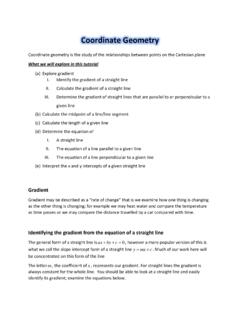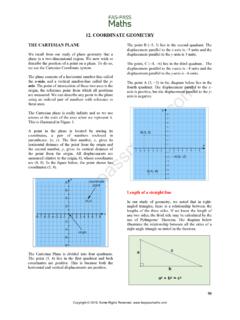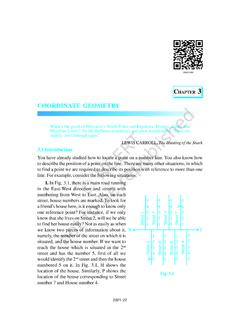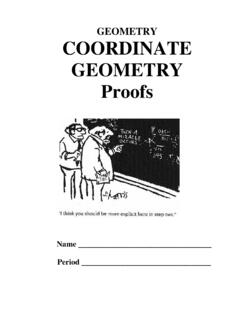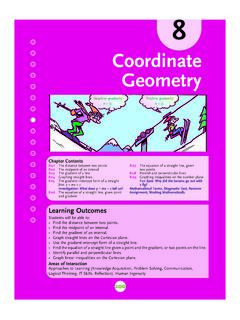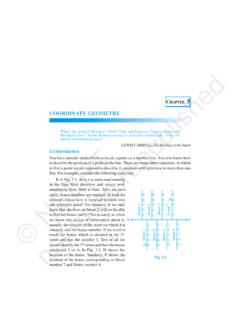Transcription of COORDINATE GEOMETRY - AMSI
1 The Improving Mathematics Education in Schools (TIMES) Project NUMBER AND ALGEBRA. Module 29. INTRODUCTION TO . COORDINATE GEOMETRY . A guide for teachers - Years 9 10 June 2011. 910. YEARS. Introduction to COORDINATE GEOMETRY (Number and Algebra : Module 29). For teachers of Primary and Secondary Mathematics 510. Cover design, Layout design and Typesetting by Claire Ho The Improving Mathematics Education in Schools (TIMES). Project 2009 2011 was funded by the Australian Government Department of Education, Employment and Workplace Relations.
2 The views expressed here are those of the author and do not necessarily represent the views of the Australian Government Department of Education, Employment and Workplace Relations. The University of Melbourne on behalf of the International Centre of Excellence for Education in Mathematics (ICE EM), the education division of the Australian Mathematical Sciences Institute (AMSI), 2010 (except where otherwise indicated). This work is licensed under the Creative Commons Attribution- NonCommercial-NoDerivs Unported License. 2011.
3 The Improving Mathematics Education in Schools (TIMES) Project NUMBER AND ALGEBRA. Module 29. INTRODUCTION TO . COORDINATE GEOMETRY . A guide for teachers - Years 9 10 June 2011. Peter Brown Michael Evans David Hunt Janine McIntosh 910. Bill Pender Jacqui Ramagge YEARS. {1} A guide for teachers INTRODUCTION. TO COORDINATE . GEOMETRY . ASSUMED KNOWLEDGE. Fluency with the arithmetic of the rational numbers Knowledge of ratios Congruent and similar triangles Basic algebraic notation Fluency with algebraic expressions and equations Basic plotting points in the Cartesian plane including plotting points from a table of values.
4 MOTIVATION. COORDINATE GEOMETRY is one of the most important and exciting ideas of mathematics. In particular it is central to the mathematics students meet at school. It provides a connection between algebra and GEOMETRY through graphs of lines and curves. This enables geometric problems to be solved algebraically and provides geometric insights into algebra. The invention of calculus was an extremely important development in mathematics that enabled mathematicians and physicists to model the real world in ways that was previously impossible.
5 It brought together nearly all of algebra and GEOMETRY using the COORDINATE plane. The invention of calculus depended on the development of COORDINATE GEOMETRY . CONTENT. It is expected that students have met plotting points on the plane and have plotted points from tables of values of both linear and non linear functions. The number plane (Cartesian plane) is divided into four quadrants by two perpendicular axes called the x-axis (horizontal line) and the y-axis (vertical line). These axes intersect at a point called the origin.
6 The position of any point in the plane can be represented by an ordered pair of numbers (x, y). These ordered pairs are called the coordinates of the point. The Improving Mathematics Education in Schools (TIMES) Project {2}. The point with coordinates (4, 2) has been y 4 x- COORDINATE plotted on the Cartesian plane shown. 3. The coordinates of the origin are (0, 0). 2 (4, 2). Once the coordinates of two points are 1 y- COORDINATE x known the distance between the two points 4 3 2 1 0 1 2 3 4. and midpoint of the interval joining the points 1.
7 2. can be found. 3. 4. DISTANCE BETWEEN TWO POINTS. Distances are always positive, or zero if the points coincide. The distance from A to B is the same as the distance from B to A. We first find the distance between two points that are either vertically or horizontally aligned. EXAMPLE. Find the distance between the following pairs of points. a A(1, 2) and B(4, 2) b A(1, 2) and B(1, 3). SOLUTION. a The distance AB = 4 1 = 3 y A(1, 2). Note: The distance AB is obtained from B(4, 2). the difference of the x- coordinates of the two points.
8 X 0. b The distance AB = 3 ( 2) = 5 y B(1, 3). Note: The distance AB is obtained from the difference of the y- coordinates of the two points. x 0. A(1, 2). {3} A guide for teachers The example above considered the special cases when the line interval AB is either horizontal or vertical. Pythagoras' theorem is used to calculate the distance between two points when the line interval between them is neither vertical nor horizontal. The distance between the points A(1, 2) and B(4, 6) is calculated below. y B(4, 6). A(1, 2) C(4, 2).
9 X 0. AC = 4 1 = 3 and BC = 6 2 = 4. By Pythagoras' theorem, AB2= 32 + 42 = 25. And so AB = 5. The general case We can obtain a formula for the length of any interval. Suppose that P(x1, y1) and Q(x2, y2). are two points. y Q(x2, y2). y2 y1. P(x1, y1) x2 x1 X(x2, y1). x 0. Form the right-angled triangle PQX, where X is the point (x2, y1), PX = x2 x1 or x1 x2 and QX = y2 y1 or y1 y2. depending on the positions of P and Q. By Pythagoras' theorem: PQ2 = PX2 + QX2. = (x2 x1)2 + (y2 y1)2. Therefore PQ = QP = (x2 x1)2 + (y2 y1)2.
10 Note that (x2 x1)2 is the same as (x1 x1)2 and therefore it doesn't matter whether we go from P to Q or from Q to P the result is the same. The Improving Mathematics Education in Schools (TIMES) Project {4}. EXAMPLE. Find the distance between the points A( 4, 3) and B(5, 7). SOLUTION. In this case, x1 = 4, x2 = 5, y1 = 3 and y2 = 7. AB2= (x2 x1)2 + (y2 y1)2. = (5 ( 4))2 + (7 ( 3))2. = 92 + 102. = 181. Thus, AB = 181. Note that we could have chosen x1 = 5, x2 = 4, y1 = 7 and y2 = 3 and still obtained the same result. As long as (x1, y1) refers to one point and (x2, y2) the other point, it does not matter which one is which.






